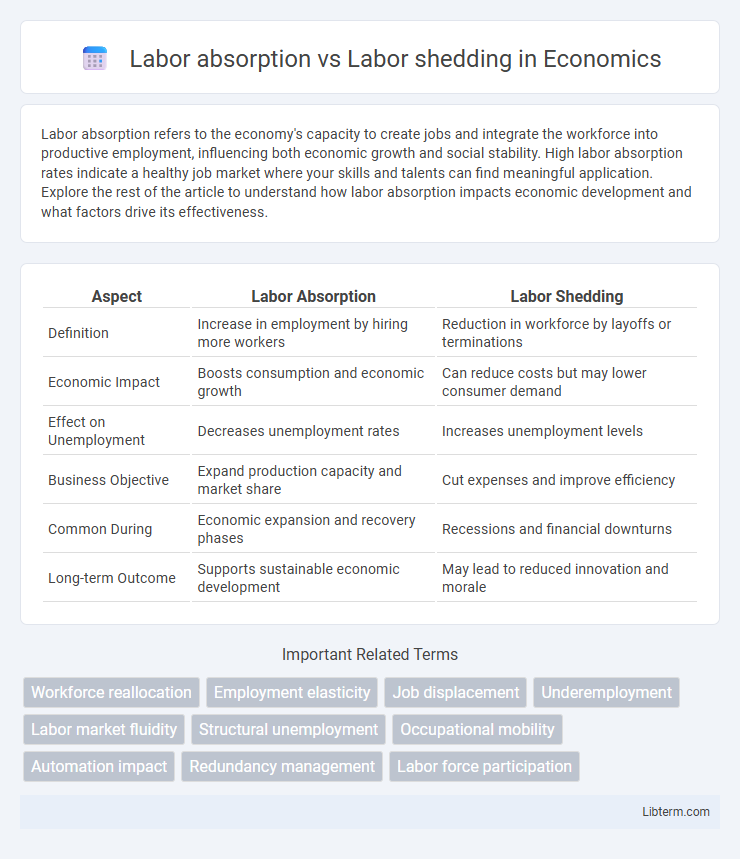Labor absorption refers to the economy's capacity to create jobs and integrate the workforce into productive employment, influencing both economic growth and social stability. High labor absorption rates indicate a healthy job market where your skills and talents can find meaningful application. Explore the rest of the article to understand how labor absorption impacts economic development and what factors drive its effectiveness.
Table of Comparison
| Aspect | Labor Absorption | Labor Shedding |
|---|---|---|
| Definition | Increase in employment by hiring more workers | Reduction in workforce by layoffs or terminations |
| Economic Impact | Boosts consumption and economic growth | Can reduce costs but may lower consumer demand |
| Effect on Unemployment | Decreases unemployment rates | Increases unemployment levels |
| Business Objective | Expand production capacity and market share | Cut expenses and improve efficiency |
| Common During | Economic expansion and recovery phases | Recessions and financial downturns |
| Long-term Outcome | Supports sustainable economic development | May lead to reduced innovation and morale |
Understanding Labor Absorption and Labor Shedding
Labor absorption refers to the economy's ability to create new jobs and integrate unemployed workers into the workforce, enhancing employment rates and supporting economic growth. Labor shedding involves the reduction of workforce through layoffs or dismissals, often in response to economic downturns or automation, which can increase unemployment and reduce consumer spending. Understanding these dynamics helps policymakers balance job creation efforts with necessary workforce adjustments to maintain economic stability.
Key Differences Between Labor Absorption and Labor Shedding
Labor absorption refers to the process of increasing employment opportunities by integrating more workers into the labor market, often driven by economic expansion and business growth. In contrast, labor shedding entails a reduction in the workforce through layoffs, attrition, or automation, typically resulting from economic downturns or organizational restructuring. The key differences lie in their impact on employment levels: labor absorption boosts job creation and reduces unemployment, while labor shedding decreases workforce size and raises unemployment rates.
Factors Influencing Labor Absorption Rates
Labor absorption rates are influenced by economic growth, technological advancements, and sectoral shifts in the economy. High labor absorption occurs when industries expand, demand for skilled labor rises, and government policies support job creation through education and training programs. Conversely, labor shedding is triggered by automation, outsourcing, and economic downturns reducing the need for human resources.
Causes and Drivers of Labor Shedding
Labor shedding primarily results from technological advancements, automation, and economic downturns, which reduce the demand for manual labor across various industries. Companies implement labor shedding to cut costs during periods of financial strain, shifts in market demand, or outsourcing to lower-wage regions. Structural changes in the economy, such as sectoral shifts away from manufacturing toward service-based industries, further drive labor shedding trends.
Economic Impacts of Labor Absorption
Labor absorption significantly boosts economic growth by increasing employment opportunities and enhancing household incomes, which in turn stimulates consumption and demand. Higher labor absorption reduces unemployment rates, leading to improved social stability and lower government spending on social welfare programs. Economies with strong labor absorption capacity often experience accelerated industrial development and higher productivity, driving sustainable development and poverty reduction.
Social Consequences of Labor Shedding
Labor shedding results in increased unemployment and underemployment, negatively impacting household income and social stability. Communities facing high labor shedding often experience diminished consumer spending, rising poverty rates, and greater reliance on social welfare programs. These social consequences can exacerbate inequality and lead to long-term socioeconomic challenges.
Strategies to Promote Labor Absorption
Strategies to promote labor absorption include investing in skill development programs to enhance workforce employability, fostering entrepreneurship to create new job opportunities, and encouraging sectors like technology, manufacturing, and services to expand their hiring capacities. Government policies such as tax incentives for businesses that increase employment and targeted support for small and medium enterprises (SMEs) can stimulate job creation. Emphasizing labor market flexibility and improving access to vocational training also facilitate smoother transitions from unemployment to employment.
Challenges in Managing Labor Shedding
Labor shedding presents significant challenges including maintaining employee morale, ensuring operational continuity, and complying with legal regulations related to layoffs. Companies must carefully manage communication to prevent productivity loss and negative public perception, while also addressing the financial and social impact on affected workers. Strategic planning and support programs are crucial to mitigate risks associated with workforce reduction and to sustain business resilience.
Global Trends in Labor Absorption and Shedding
Global labor absorption trends indicate a steady increase in employment opportunities driven by emerging sectors such as technology, renewable energy, and healthcare, reflecting shifts in economic structures worldwide. Conversely, labor shedding is prevalent in industries facing automation and digital transformation, notably manufacturing and traditional retail, leading to significant workforce reductions. These contrasting patterns underscore the dynamic global labor market, where skill adaptation and sectoral shifts define employment prospects.
Policy Recommendations for Sustainable Labor Markets
Implement policy frameworks that promote labor absorption by investing in skills development, vocational training, and inclusive employment programs to enhance workforce adaptability and reduce unemployment. Encourage public-private partnerships to stimulate job creation in emerging sectors, ensuring balanced labor demand and supply dynamics that prevent labor shedding. Strengthen social protection systems and implement active labor market policies to support displaced workers and facilitate smooth transitions into new employment opportunities.
Labor absorption Infographic

 libterm.com
libterm.com